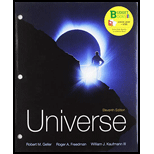
Concept explainers
(a)
The value of
(a)
Answer to Problem 53Q
Solution:
Explanation of Solution
Given data:
The value of the redshift is 0.5.
Using table 25-2, the value of
The formula for the deceleration parameter at redshift z is
Formula used:
The given formula is written as,
Here,
Explanation:
Recall the provided formula.
Substitute 0.5 for z and 0.76 for
Conclusion:
Therefore, the value of
(b)
The value of
(b)
Answer to Problem 53Q
Solution:
0.074
Explanation of Solution
Given data:
The value of the redshift is 1.
Using table 25-2, the value of
Formula used:
The provided formula is written as:
Here,
Explanation:
Recall the provided formula.
Substitute 1 for z and 0.76 for
Conclusion:
Therefore, the value of
(c)
An explanation for the result that shows that the expansion of the universe was decreasing at
(c)
Explanation of Solution
Given data:
The values of the redshift are 1 and 0.5.
Using table 25-2, the value of
Formula used:
The provided formula is written as:
Here,
Explanation:
The value of
A positive value of
Conclusion:
Therefore, the universe accelerated between redshift 1 and 0.5.
Want to see more full solutions like this?
Chapter 25 Solutions
Universe - Text Only (Looseleaf)
- Show that for a particle is invariant under Lorentz transformations.arrow_forwardWhat is the relative velocity of two spaceships if one fires a missile at the other at 0.750c and the other observes it to approach at 0.950c?arrow_forwardFigure P9.21 shows a jet of material (at the upper right) being ejected by galaxy M87 (at the lower left). Such jets are believed to be evidence of supermassive black holes at the center of a galaxy. Suppose two jets of material from the center of a galaxy are ejected in opposite directions. Both jets move at 0.750c relative to the galaxy center. Determine the speed of one jet relative to the other. Figure P9.21arrow_forward
- If two spaceships are heading directly toward each other at 0.800c, at what speed must a canister be shot from the first ship to approach the other at 0.999c as seen by the second ship?arrow_forwardA box is cubical with sides of proper lengths L1 = L2 = L3, as shown in Figure P26.14, when viewed in its own rest frame. If this block moves parallel to one of its edges with a speed of 0.80c past an observer, (a) what shape does it appear to have to this observer? (b) What is the length of each side as measured by the observer? Figure P26.14arrow_forwardAn observer standing by the railroad tracks sees two bolts of lightning strike the ends of a 500-m-long train simultaneously at the instant the middle of the train passes him at 50 m/s. Use the Lorentz transformation to find the time between the lightning strikes as measured by a passenger seated in the middle of the train.arrow_forward
- Suppose our Sun is about to explode. In an effort to escape, we depart in a spaceship at v = 0.80c and head toward the star Tau Ceti, 12 lightyears away. When we reach the midpoint of our journey from the Earth, we see our Sun explode and, unfortunately, at the same instant we see Tau Ceti explode as well. (a) In the spaceship’s frame of reference, should we conclude that the two explosions occurred simultaneously? If not, which occurred first? (b) In a frame of reference in which the Sun and Tau Ceti are at rest, did they explode simultaneously? If not, which exploded first?arrow_forwardThe proper length of one spaceship is three times that of another. The two spaceships are traveling in the same direction and, while both are passing overhead, an Earth observer measures the two spaceships to have the same length. If the slower spaceship is moving with a speed of 0.35c, determine the speed of the faster spaceship.arrow_forwardWhat will be the mean lifetime of a muon as measured in the laboratory if it is traveling at v = 0.6c with respect to the laboratory? A muon’s mean lifetime at rest is 2.20 μs. (ii) How far does a muon travel in the laboratory, on average, before decaying?arrow_forward
- How fast must a pion be moving on average to travel32 m before it decays? The average lifetime, at rest, is 2.6 x10-8 sarrow_forwardSuppose you are planning a trip in which a spacecraft is to travel at a constant velocity for exactly six months, as measured by a clock on board the spacecraft, and then return home at the same speed. Upon return, the people on earth will have advanced exactly 76 years into the future. According to special relativity, how fast must you travel? (Give your answer with six significant digits as a multiple of c.)arrow_forward
 Physics for Scientists and Engineers: Foundations...PhysicsISBN:9781133939146Author:Katz, Debora M.Publisher:Cengage Learning
Physics for Scientists and Engineers: Foundations...PhysicsISBN:9781133939146Author:Katz, Debora M.Publisher:Cengage Learning Classical Dynamics of Particles and SystemsPhysicsISBN:9780534408961Author:Stephen T. Thornton, Jerry B. MarionPublisher:Cengage Learning
Classical Dynamics of Particles and SystemsPhysicsISBN:9780534408961Author:Stephen T. Thornton, Jerry B. MarionPublisher:Cengage Learning Modern PhysicsPhysicsISBN:9781111794378Author:Raymond A. Serway, Clement J. Moses, Curt A. MoyerPublisher:Cengage Learning
Modern PhysicsPhysicsISBN:9781111794378Author:Raymond A. Serway, Clement J. Moses, Curt A. MoyerPublisher:Cengage Learning Principles of Physics: A Calculus-Based TextPhysicsISBN:9781133104261Author:Raymond A. Serway, John W. JewettPublisher:Cengage Learning
Principles of Physics: A Calculus-Based TextPhysicsISBN:9781133104261Author:Raymond A. Serway, John W. JewettPublisher:Cengage Learning University Physics Volume 3PhysicsISBN:9781938168185Author:William Moebs, Jeff SannyPublisher:OpenStax
University Physics Volume 3PhysicsISBN:9781938168185Author:William Moebs, Jeff SannyPublisher:OpenStax College PhysicsPhysicsISBN:9781305952300Author:Raymond A. Serway, Chris VuillePublisher:Cengage Learning
College PhysicsPhysicsISBN:9781305952300Author:Raymond A. Serway, Chris VuillePublisher:Cengage Learning





